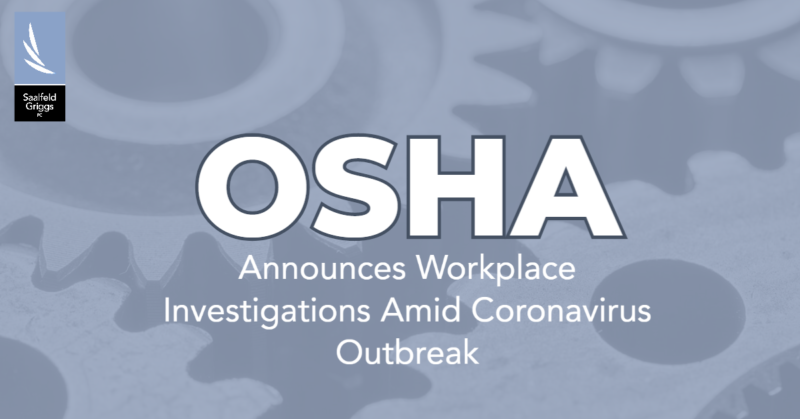By David Briggs, Attorney in the Employment Law and Litigation Practice Groups
The flood of new state and federal regulations has wreaked havoc on many employers struggling with payroll, layoffs, new paid leave laws, government protections, and loans. Now to top it all off, OSHA has announced that it has started doing unannounced inspections.
It may not be surprising that OR-OSHA has received over 2,200 complaints about workplace violations related to the coronavirus outbreak in just the past two weeks. That’s more complaints than OSHA typically gets in a year.
In response, OSHA is taking a variety of steps including:
- Unannounced workplace visits;
- Sending complaints to employers in order to receive a written response; or
- Calling employers to inquire about policies and practices.
Among the industries most likely to see follow up from OSHA are manufacturing, retail, healthcare, and construction/landscaping.
The scariest of these options is obviously an OSHA visit. So, we thought it would be beneficial to outline some of your rights in these situations (spoiler alert: you don’t have many).
Typical Process
For those who haven’t had the privilege of an investigation, a typical investigation begins with a short meeting with the investigator. As a result, you will want to have someone designated ahead of time. That is typically a safety officer and/or social distancing officer. At the meeting, the investigator will present credentials and explain the purpose and scope of the visit. They will typically ask for records, including policies and manuals.
The investigator will then conduct the investigation including walking around the worksite, taking pictures, and interviewing employees.
In a typical complaint, an employee may complain about the safety of a specific piece of machinery.
OSHA would then come and perform a “reasonable” search which may include inspecting that machine to observe how it works, and ask to review manuals, policies, and procedures related to its operation. However, when dealing with a complaint related to COVID-19 social distancing and disinfecting guidelines, the whole workplace seems to fall within a “reasonable” search.
After the investigation is complete, the investigator will conduct a closing conference to discuss findings and advise the company if there are any violations and/or safety hazards that need to be remediated. They will also discuss timelines for correcting hazards, possible penalties, and appeal rights.
OSHA’s Rights
First off, OSHA has the legal authority to inspect a workplace for compliance with safety standards – even without providing written notice. There are limitations to this authority. OSHA is generally limited to working hours or other “reasonable times, within reasonable limits, and in a reasonable manner.” And, if you’ve ever talked to a lawyer, you will know that “reasonable” is not a very clear guideline. The takeaway if that investigators can typically access your workplace during working hours and in a way that they can determine whether sound safety practices are being followed.
The investigator will have the right to talk to employees, take pictures and take samples while onsite.
Discussions with employees are typically held confidentially and without management representatives present. If an employee’s request management present for the meeting, the request may be honored, but OSHA does not need to comply with the request.
Employers’ Rights
You can have an employer representative accompany the investigator during an inspection. If you disagree with OSHA’s findings, you can also appeal the findings.
Unfortunately, that is about the extent of employers’ rights.
What to Do Now
OSHA has warned that it may issue fines for failure to comply with social distancing guidelines, work from home directives, allowing coronavirus-infected employees to come to work (or requiring them to do so), or failure to properly clean or sanitize the workplace. A spokesman for OSHA stated “If we inspect and find violations, we cite. If we identify and classify violations as serious, there will be a penalty.”
Going forward, things to do include:
- Review guidelines from OR-OSHA, federal OSHA, and the CDC;
- Ensure that policies are properly circulated;
- Enforce policies and review the workplace for ways to ensure compliance with rules – in particular, social distancing rules; and
- Discipline employees who violate these rules and policies.
If you have questions about how to prepare for an inspection or have OR-OSHA asking questions, please contact David Briggs or a member of the Saalfeld Griggs Employment Team.
David Briggs is a partner in the Employment Law and Litigation practice groups, and a member of the Agri-Business, Dental and Health Law industry teams.The information in this article is not intended to provide legal advice. For professional consultation, please contact David at dbriggs@sglaw.com at Saalfeld Griggs PC. 503.399.1070. © 2020 Saalfeld Griggs PC


